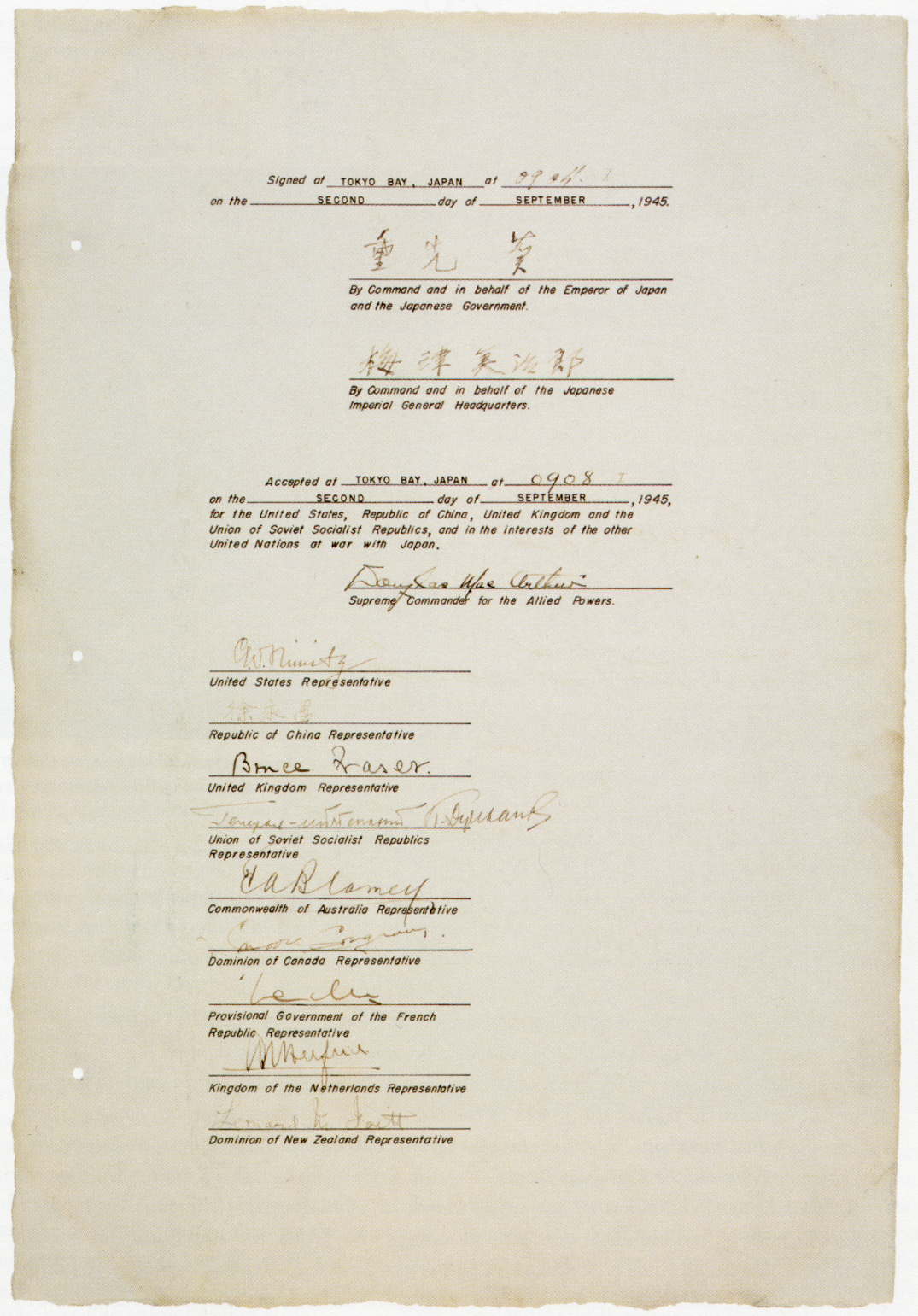The
Surrender of Japan |


Gen. MacArthur (at microphone)
watches as Japanese Gen. Yoshijiro Umezu signs the surrender document
aboard the battleship U.S.S.
Missouri
in Tokyo Bay on the morning of September 2, 1945
Department of the Navy
| The last few months of World War II
saw intense fighting in the Pacific. Battles raged in the Philippines and
on the islands of Iwo Jima and Okinawa. In July 1945, while attending a
summit in Potsdam, Germany, President Harry S Truman learned that American
scientists had successfully tested an atomic bomb. Casualty estimates persuaded
him that he could avoid a full-scale invasion of the main island of Japan
if he ordered the use of this weapon. A vaguely worded ultimatum to Japan
elicited no response and, as a result, Truman ordered the bombing, first
of Hiroshima, and then of Nagasaki. Emperor Hirohito announced Japan's
surrender on August 14, five days after the United States dropped the second
atomic bomb. Formal surrender took place on September 2, aboard the USS
Missouri in Tokyo Bay. The official Instrument of Surrender, which the
War Department prepared and President Truman then approved, called—in eight
short paragraphs—for the complete capitulation of Japan. "We hereby proclaim,"
the document reads, "the unconditional surrender to the Allied Powers of
the Japanese Imperial General Headquarters and of all Japanese armed, forces
and all armed forces under Japanese control wherever situated." Foreign
Minister Mamoru Shigemitsu and General Yoshijiro Umezu signed for Japan.
The official time was 4 minutes past 9 o'clock. General Douglas
MacArthur, Commander in the Southwest Pacific and Supreme Commander for the Allied Powers, also signed, expressing the hope "that from this solemn occasion a better world shall emerge... a world founded on faith and understanding. " One of the Japanese diplomats wondered, perhaps more poignantly, "whether it would have been possible for us, had we been victorious, to embrace the vanquished with a similar magnitude." This surrender ended World War II and set the stage for a democratic government in Japan. |

|
INSTRUMENT OF SURRENDER
We hereby proclaim the unconditional surrender to the Allied Powers of the Japanese Imperial General Headquarters and of all Japanese armed forces and all armed forces under the Japanese control wherever situated. We hereby command all Japanese forces wherever situated and the Japanese people to cease hostilities forthwith, to preserve and save from damage all ships, aircraft, and military and civil property and to comply with all requirements which my be imposed by the Supreme Commander for the Allied Powers or by agencies of the Japanese Government at his direction. We hereby command the Japanese Imperial Headquarters to issue at once orders to the Commanders of all Japanese forces and all forces under Japanese control wherever situated to surrender unconditionally themselves and all forces under their control. We hereby command all civil, military and naval officials to obey and enforce all proclamations, and orders and directives deemed by the Supreme Commander for the Allied Powers to be proper to effectuate this surrender and issued by him or under his authority and we direct all such officials to remain at their posts and to continue to perform their non-combatant duties unless specifically relieved by him or under his authority. We hereby undertake for the Emperor, the Japanese Government and their successors to carry out the provisions of the Potsdam Declaration in good faith, and to issue whatever orders and take whatever actions may be required by the Supreme Commander for the Allied Powers or by any other designated representative of the Allied Powers for the purpose of giving effect to that Declaration. We hereby command the Japanese Imperial Government and the Japanese Imperial General Headquarters at once to liberate all allied prisoners of war and civilian internees now under Japanese control and to provide for their protection, care, maintenance and immediate transportation to places as directed. The authority of the Emperor and the Japanese Government to rule the state shall be subject to the Supreme Commander for the Allied Powers who will take such steps as he deems proper to effectuate these terms of surrender. Signed at TOKYO
BAY, JAPAN at 0904
By command and in behalf of the Emperor of Japan and the Japanese Government. [YOSHIJIRO UMEZU] By command and in behalf of the Japanese Imperial General Headquarters. Accepted at TOKYO BAY, JAPAN at 0908 on the SECOND day of SEPTEMBER , 1945, for the United States, Republic of China, United Kingdom and the Union of Soviet Socialist Republics, and in the interests of the other United Nations at war with Japan. Supreme Commander for the Allied Powers
C.W. Nimitz
[HSU
YUNG-CHANG]
Bruce Fraser
Kuzma Derevyanko
Thomas Blamey
L.
Moore Cosgrave
Jacques Leclerc
C.E.L. Helfrich
Leonard M. Isitt
|

